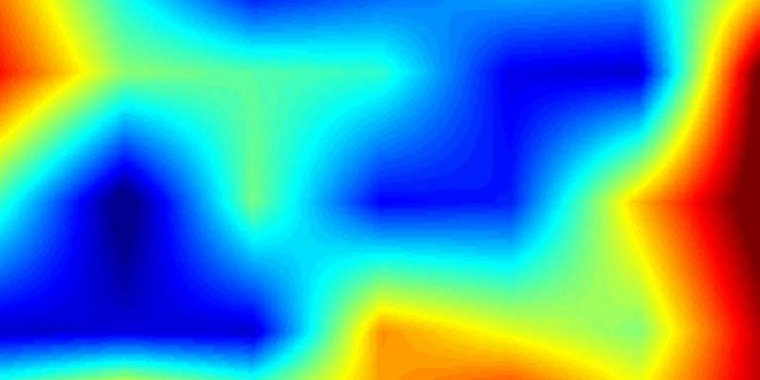| News / Science News |
Scientists discover how our brains track where we and others go
For the first time, scientists have recorded how our brains navigate physical space and keep track of others’ location.

NIH BRAIN Initiative-funded researchers used a special backpack to wirelessly monitor the brain waves of epilepsy patients as they searched for a hidden spot in an empty square room. Photo: Suthana lab, UCLA.
Researchers used a special backpack to wirelessly monitor the brain waves of epilepsy patients as each one walked around an empty room hunting for a hidden, two-foot spot.
The scientists report that the waves flowed in a distinct pattern suggesting that each individual’s brain had mapped out the walls and other boundaries.
Interestingly, each participant’s brain waves flowed in a similar manner when they sat in the corner of the room and watched someone else walk around, suggesting these waves were also used to track other people’s movements.
“We were able to directly study for the first time how a person’s brain navigates an actual physical space that is shared with others,” said Nanthia Suthana, Ph.D., an assistant professor of neurosurgery and psychiatry at the David Geffen School of Medicine at the University of California, Los Angeles (UCLA) and senior author. “Our results suggest that our brains may use a common code for knowing where we and others are in social settings.”
Dr. Suthana’s lab studies how the brain controls learning and memory. In this study, her team worked with a group of participants with drug-resistant epilepsy, 31-52 years old, whose brains have been surgically implanted with electrodes to control their seizures.
The electrodes reside in a memory center in the brain called the medial temporal lobe, which is also thought to control navigation, at least in rodents. Over the past half century, scientists discovered – in experiment after experiment – that neurons in this lobe, known as grid cells and place cells, act like a global positioning system.
Moreover, the scientists found that low frequency waves of neural activity by these cells, called theta rhythms, help rodents know where they and others are while running through a maze or swimming around a shallow pool of water.
“Several pieces of indirect evidence support the medial temporal lobe’s role in how we navigate. But testing these ideas any further has been technically difficult,” said Matthias Stangl, Ph.D., a postdoctoral scholar at UCLA and the lead author of the article.
This study provides the most direct evidence to date supporting these ideas in humans and it was made possible by a special backpack which Dr. Suthana’s team invented.
At its core, the backpack contained a computer system which can wirelessly connect to the electrodes surgically implanted in a patient’s head. Recently, the researchers showed that the computer can simultaneously be hooked up to several other devices including virtual reality goggles, eye trackers, and heart, skin, and breathing monitors.
“Until now the only ways to directly study human brain activity required a subject to be still, either lying in a massive brain scanner or hooked up to an electrical recording device. In 2015, Dr. Suthana came to me with an idea for solving this problem and so we took a chance on making a backpack,” said Uros Topalovic, M.S., a graduate student at UCLA and an author of the study. “The backpack frees the patient and allows us to study how the brain works during natural movements.”
To examine the role the medial temporal lobe plays in navigation the researchers asked the research participants to put on the backpack and enter an empty 330-square-foot room.
Each wall was lined with a row of five colored signs numbered 1 through 5, one color per wall. Through a ceiling mounted speaker, a computerized voice asked the patient to walk to one of the signs. Once they arrived at the sign the voice then asked them to search for a two-foot in diameter spot hidden somewhere in the room.
Meanwhile the backpack recorded the patient’s brain waves, paths through the room, and eye movements.
Initially, each person needed several minutes to find the spot. During subsequent trials, the time shortened as their memory of the spot’s location improved.
The electrical recordings revealed a distinct pattern in brain activity. The theta rhythms flowed stronger - with higher peaks and lower valleys - when the participants approached a wall than when they wandered in the middle of room. This happened exclusively when they were searching for the spot.
In contrast, the researchers saw no correlation between theta rhythm strength and location when the participants followed directions for walking to the colored signs on the wall.
“These results support the idea that under certain mental states theta rhythms may help the brain know where boundaries are located. In this case it’s when we are focused and searching for something,” said Dr. Stangl.
Curiously, they saw similar results when the participants watched someone else search for a spot. In these experiments, the participants would sit on a chair in the corner of the room with their backpacks on and their hands resting near a keyboard.
The patients knew the location of the hidden spot and they pressed a button on the keyboard whenever the other person arrived at it.
Again, the participant’s brain waves flowed strongest when the other person either neared a wall or the spot and this pattern only appeared when the person was on the hunt rather than following specific directions.
“Our results support the idea that our brains may use these wave patterns to put ourselves in another person’s shoes,” said Dr. Suthana. “The results open the door to helping us understand how our brains control navigation and, possibly, other social interactions.” (National Institutes of Health)
YOU MAY ALSO LIKE





